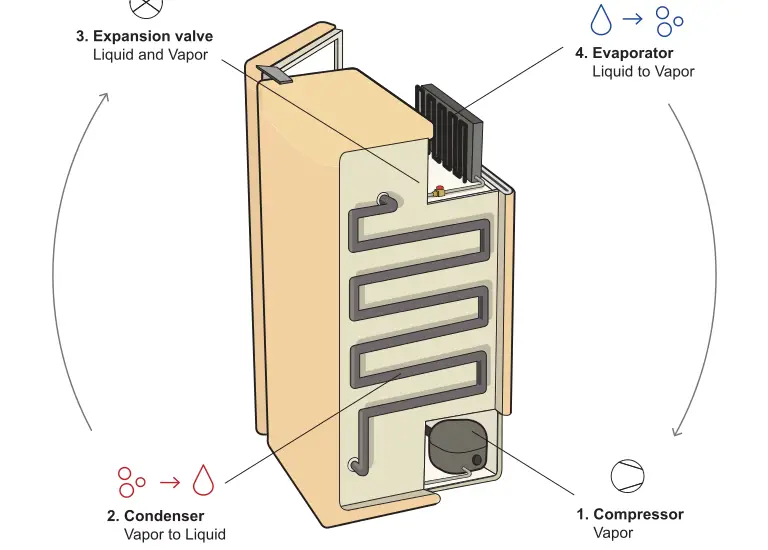How a condenser works in a refrigerator isn’t just science stuff – it’s your personal summer day chill pill. This compact piece of machinery is a maestro, masterminding the entire cooling process, and today, we’re going to give it the spotlight it deserves.

Table of Contents
Brief Overview of How a Condenser Works in Refrigeration
You know the lovely chill you get when you open your refrigerator? That’s the condenser’s gift to you. Acting as a heat exchanger, it cools down and condenses the refrigerant vapor into liquid, expelling the heat from your fridge. A crucial step to keep your ice cream from turning into soup, right?
Understanding the Refrigeration Cycle
A refrigerator isn’t just a magic box that keeps things cool. It operates in a carefully choreographed cycle that revolves around four main players: the compressor, condenser, expansion valve, and evaporator. It’s a fascinating dance of heat transfer and transformation that keeps your summer treats perfectly chilled.
Role of the Condenser in the Refrigeration Cycle
Picture the refrigeration cycle as a relay race. The baton is the refrigerant, and it’s passed between four key players: the compressor, the condenser, the expansion valve, and the evaporator.
The condenser’s job? Grab that baton from the compressor, which is hot and under high pressure, and cool it down, turning it from vapor to liquid. Now that’s a cooling baton pass!
The Four Main Components in the Refrigeration Cycle
Imagine you’ve got a rock band. The compressor, condenser, expansion valve and evaporator are the band members.
The compressor and the condenser are like the drummer and bassist – they set the rhythm, or in our case, manage the pressure and temperature.
The expansion valve and evaporator are the guitarist and vocalist – they create the music or cool the refrigerant. The condenser, our bassist, keeps everything cool while the show goes on.
Deep Dive into the Condenser
Now that we’ve seen the larger picture, let’s zoom in on one crucial player: the condenser. This workhorse not only transforms the refrigerant from a hot gas to a cool liquid but also expels the unwelcome heat from your fridge. Let’s break it down and see how each part plays its role in this cooling dance.
Anatomy of a Condenser
Just like us, the condenser has its unique parts. And boy, do they work together seamlessly. The condenser coil and the fan are the main stars. They’re like two partners dancing a tango, each step meticulously choreographed for the greatest cooling performance.
Condenser Coils
The condenser coils are like a winding river where the refrigerant flows, losing heat along the way. These coils are usually made of copper for their fantastic heat transfer abilities.
The result? A chilly refrigerant ready to go back and collect more heat from the fridge’s interior. Imagine it as the fridge’s personal heat detective, finding and removing the unwanted heat.
Condenser Fan
Meet the wingman of the condenser coils – the condenser fan. This fan blows air over the coils, whisking away the heat the refrigerant has gathered from inside the fridge. If the coils are a river, then the fan is the breeze that helps keep the river cool.
The Process of Condensation
Think about the last time you saw dew on a leaf on a cool morning. That’s nature’s version of condensation. In a fridge, the condenser takes the high-pressure, high-temperature refrigerant gas from the compressor, and cools it.
This transforms the refrigerant into a high-pressure liquid, ready to be sent back into the fridge to absorb more heat. It’s like a cooling relay race that never ends.
Check out these other related articles…
Condenser Noise: Proven Solutions
Function of a Condenser in a Refrigeration System: 101 Guide
Condenser Overheating: Causes & Proven Solutions
Bad Condenser Symptoms: Your Comprehensive 101 Guide
Blocked Condenser Coil Symptoms: Comprehensive 411 Guide
The Condenser’s Role in Energy Efficiency
But it’s not just about keeping things cool. The condenser also plays a vital role in making your refrigerator energy efficient. Let’s see how taking care of your condenser can be an eco-friendly and wallet-friendly move.
How the Condenser Contributes to Refrigerator Efficiency
Here’s food for thought – did you know that a well-functioning condenser can make your fridge more energy efficient? A condenser in top shape can cool the refrigerant more effectively, which means less work for the compressor and less energy used. So, a happy condenser equals a happy electricity bill.
The Impact of Condenser Maintenance on Energy Efficiency
Just like a car, your fridge’s condenser needs regular check-ups. If the condenser coils get dusty, the condenser has to work harder to cool the refrigerant. And guess what? That means more energy is used.
A little cleaning and your condenser will be singing a tune of efficiency in no time.